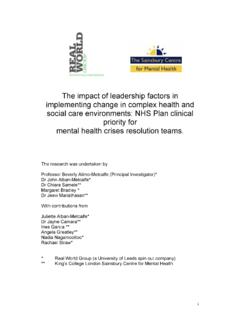Transcription of Health Care Worker Health and Safety - WHO
1 Health care Worker Health and Safety :Preventing Needlestick Injury and Occupational Exposure to Bloodborne PathogensWorld Health OrganizationInternational Council of NursesWHO-ICN ProjectPreventing Needlestick Injury and HIV among Health care Workers One year project extended for 3 years Funded by the US CDC National Institute for Occupational Safety & Health (NIOSH) to reduce occupational exposure and transmission of HIV and other bloodborne pathogens Pilot projects in 3 countries: So Africa, Tanzania, & Vietnam will be carried out in collaboration with WHO (hq + regional), MOH, national nurses associations, and WHO Occupational Health Collaborating Centers. Scaling up in southern Africa SADC region to implement successes of the pilot project. Occupational Hazards are the same .. Biological (SARS, TB, Anthrax, HIV, Hepatitis) Chemical (drugs, disinfectants, sterilants) Ergonomic (lifting, transfers) Stress/Violence (staffing shortages, shift rotation) Physical Hazards (radiation,heat,noise)But work environments are differentOccupational Exposure to Bloodborne Pathogens 2 million exposures per yearIn Healthcare workers: 40% of Hepatitis B 40% of Hepatitis C of HIV Are due to needlestick injuries (50% of hospitalized patients in sub-Saharan Africa are HIV +)WHO Environmental Burden of Diseases Series No.
2 3 Risk of Virus TransmissionFollowing Percutaneous InjuryVirusChance of HCW InfectionHBV6 30 out of 100 peopleHCV3 10 out of 100 peopleHIV1 out of 300 peopleRisk Factors that Increase the Likelihood of HIV Transmission Following a Needlestick#1 Deep injury#2 High viral titer in patient#3 Visible blood on device#4 Device in artery/veinCDC, MMWR 6/98**Treatment of healthcare workers with AZT following needlesticksinvolving an HIV positive source patient have been shown to decrease the risk of HIV transmission by 80%.Highest Risk NeedlesticksCDC, HIV-AIDS Prevention, 12/98Of the 55 CDC documented cases of occupational transmission of HIV, 90% were from contaminated hollow- bore needles that pierced the skin05101520253035 Devices Associated with Percutaneous Injuries, 1999N = 4951 injuries; Source: CDC NaSH data 1995-1999 HypodermicGlass% oftotalinjuriesSutureButterflyOtherhollo wboreIV styletPhlebotomyOtherCircumstances Associated with Hollow-Bore Needle Injuries (US CDC NaSH 6/95-12/01)Behaviors Associated with Recent Needle Stick InjuryHealth care Worker Survey 2001(Egypt)Two Hand recappingBending needleCollection of GarbageSuturing Patient causesUnknownOccupational Exposures57%Cambodia47%South AfricaJr Doctors 91% (55% to HIV) (Cotton, Stellenbach U)Egypt nsi/yr60%EMRO50% mean of 4 nsi/yr(9 of 23 countries surveyed)71%32%Burkina Faso 2000 - 55 %2003 - 17 % Uganda 44%57%Kenya- 75% (2-3 nsi/yr)2-handed recap% of hcw with 1 or > nsi/yearOccupational Health Hierarchy of ControlsIn Order From Most to Least Effective Elimination or substitution of sharp (eliminate unnecessary injections,jet injectors, needleless IV systems,)
3 Engineering Controls (A-D syringes, safer needle devices) Administrative and Work Practice Controls (Universal Precautions, no recapping, provision & placement & removal of sharps containers) Personal Protective Equipment (gloves, masks, gowns, etc)Decline in HBV Cases Among Healthcare Workers Following Vaccination04,0008,00012,00016,00020,000 198319911995 OSHA mandates HBV vaccination17,000800 This regulation had the greatest impact in eliminating HBV transmission among healthcare F et al. Archives of Int Med 157 (1997): 2601-2603 But .. Over 80% of Healthcare Workers Remain Unimmunized in many parts of the worldDespite 95% Efficacy of HBV ImmunizationA safe injection does not harm the recipient, does not expose the provider to any avoidable risk, and does not result in any waste that is dangerous for other peopleProject GoalsPreventing Needlestick Injury and HIV among Health care Workers Reduce exposure to HIV and other sharps-related infections (Hepatitis B and C) in healthcare workers Raise awareness on the risks of sharps-related HIV and hepatitis B & C transmission Implement programmes in 3 countries using existing systems and guidelines (ICN, ILO, WHO) Assess & address policy gaps Develop nsi surveillance system Train healthcare workers Implement and evaluate the injection Safety tool kitKey Elements of Project Meeting: management commitment and Worker involvement assessment.
4 Infection prevention and up surveillance control program including post-exposure follow-up and , Education, Communication : sharps containers, PEP, HBV supervision and to site, stakeholders, and MOH on progressExposure control planning Management Commitment and Worker Involvement Determination of Exposure: case definition Hepatitis B immunization Post-exposure evaluation and follow-up Communication of hazards to employees and training Recordkeeping (sharps injury log, surveillance system) and use of info/data for prevention Procedure for evaluating circumstances surrounding an exposure. Implementation of methods of exposure control (apply hierarchy of controls)REPORTING IS IMPORTANT (but 40 -70 % of injuries go unreported)Reporting Ensures Proper treatment & follow-up Financial compensation, if necessary Engineering or procedure changes BarriersTo Reporting Fear of being punished or fired Lack of awareness of risk of infection Lack of assurance of confidentiality Emphasis on patient care (unable to leave patient care area for follow-up) No employee training on reporting procedures No post-exposure treatment/prophylaxis availableReporting RecommendationsThe SHARPS INJURY LOG should include: Date, time, and location (work area and site on body of injured) of injury Case report # of injured Source patient status (if known) Type of exposure.
5 Blood-filled device, splash, or body fluid exposure The device involved (type and brand, if known) A description of the events that resulted in the injury Post-exposure follow-up: when PEP started if givenTHANK YOU!For Caring for those who care !















